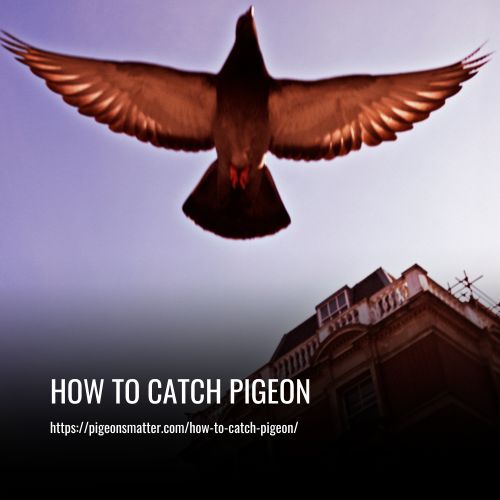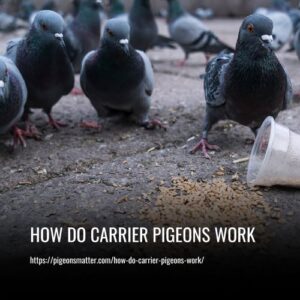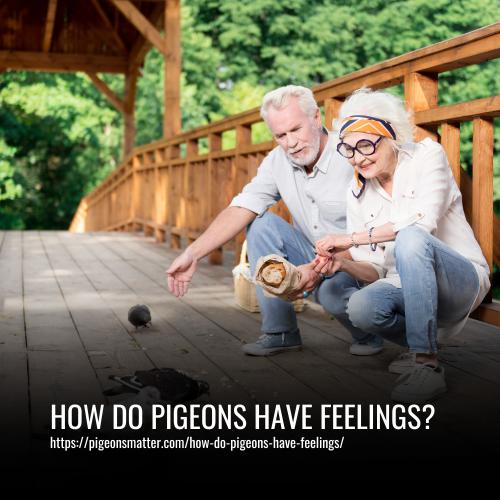To Catch a Pigeon, follow these steps:
- Choose a Trap Location.
- Place Pigeon Feed.
- Place Trap With Food Inside.
- Relocate Pigeons Away From Your Property.
- Keep the Pigeon as a Pet.

How To Catch A Pigeon In Your Backyard
If you’re looking to catch a pigeon in your backyard, a bird trap is the simplest and most effective method. Follow these steps to attract, capture, and either release or keep the pigeons with ease.
Step 1: Choose a Trap Location
If you’re planning on catching pigeons in your backyard, it’s important to choose a convenient location. Look for an area that is easily accessible to both you and the pigeons you want to catch.
To effectively maintain the trap and provide food for the pigeons, it is important to choose a location that is easily accessible and can be checked daily.
Step 2: Place Pigeon Feed
If you’re trying to trap pigeons, it’s important to attract them to the location first. You can do this by placing pigeon food out at least once a day, preferably for a week, to attract as many pigeons as possible. This will increase the likelihood of them being around when you set up your trap.
In terms of pigeon food, consider using a product that provides balanced dietary nutrition to wild or captive pigeons and doves. Look for options that are enriched with vitamins and minerals and packed in airbags for freshness and to keep insects out. A 3-pound bag should be sufficient to start attracting pigeons to your trap location.
Step 3: Place Trap With Food Inside
To catch pigeons, one can use a trap that suits their needs. It’s important to carefully read the instructions to properly set up and operate the trap door.
To set up the trap, place pigeon feed both inside and outside of the trap’s door. A suggested trap option is the Collapsible Double Door Pigeon Trap.
Step 4: Relocate Pigeons Away From Your Property
After catching pigeons in your trap, it’s important to release them far from your property to prevent them from returning. Select a location that is not near other property owners who may not desire to be in that situation either.
Pigeons can find their way back home from hundreds of miles away, so if they were on your property for a while, they may associate it with a food source and try to return.
To prevent pigeons from returning, it’s a good idea to implement pigeon deterrents. These deterrents will not only keep pigeons away but also prevent other birds from making your property their home. We’ll discuss different types of pigeon deterrents later in this article.
Step Five (Option Two): Keep the Pigeon as a Pet
Pigeons can make great pets as long as you have a manageable number and proper housing for them.
Pigeons may have a reputation for being unruly in groups, but they can be quite friendly and even affectionate with their owners.
When keeping pigeons as pets, it’s important to provide them with a clean and safe living space. This can be accomplished by building or purchasing a suitable coop or aviary.
It’s also important to provide your pigeons with a healthy diet, consisting of a mix of grains, seeds, and vegetables.
Regular veterinary check-ups are recommended to ensure your pigeons stay healthy and free from disease.
Overall, pigeons can be a rewarding and enjoyable pet for those willing to put in the time and effort to care for them properly.
How to Catch a Pigeon in Your House (or any enclosed Space)
Remaining calm is crucial when dealing with a trapped pigeon. Stress can hinder your ability to handle the bird safely and effectively.
Encouraging the bird to leave on its own is the best option. If possible, open a window and door in the room and give the pigeon easy access to escape. Leave the room and wait for the bird to leave before re-entering.
If catching the bird is necessary, wait until it settles on a surface before attempting to trap it. Use a receptacle that is large enough to avoid damaging the bird’s wings or head. If a pigeon becomes trapped, it is recommended to carefully transport it outside and set it free.
1. How to Catch a Pigeon Outdoors:
If you need to catch a pigeon, it’s important to do so in a humane way, especially if the bird is injured and needs medical attention. However, catching pigeons is not a common practice as they are often considered pests and people prefer to deter them.
- Catching with Bare Hands: While some people claim that it’s possible to catch a pigeon with bare hands, it’s only feasible if the bird has limited mobility and cannot fly away. It’s important to approach the bird slowly and calmly to avoid causing further injury or distress. If the pigeon can fly, it’s best to use other methods to catch it.
- Humane Methods: To catch a pigeon humanely, you can use a bird net or trap. These tools allow you to catch the bird without causing harm and can be used to transport the pigeon to an animal care facility. It’s important to handle the bird gently to avoid causing further injury or stress. Once caught, the pigeon should be taken to a professional for medical attention.
2. Catch a pigeon with a net:
Catching a bird or pigeon requires careful consideration to ensure the safety and well-being of the animal. Using a fine-meshed net with a padded rim is essential to avoid entangling the bird’s feet and beak. However, it’s crucial to wait until the bird has landed before attempting to catch it with a net.
Luring a pigeon with food is a more practical solution. Baiting a cage trap with food is an effective way to capture a pigeon, but it may take time for the bird to learn that food will be available regularly. Another option is to lay down food and pick up the desired pigeon while it is feeding, provided you can get close enough.
If all else fails, throwing a lightweight fabric item over the pigeon can prevent it from flying away, allowing you to pick it up safely. Remember to handle the bird carefully and release it back into the wild as soon as possible.
How to Catch a Pigeon Safely Without Hurting It
With 18 million feral pigeons in the UK, it’s no surprise that humans have frequent interactions with these birds. There may be situations where you need to pick up a pigeon, but it can be challenging to do so safely. Here are some tips to help you catch a pigeon safely.
- Approach the pigeon slowly and calmly, without making sudden movements or loud noises that could startle it.
- Use a towel or cloth to gently cover the pigeon’s head, which will calm it down and make it easier to handle.
- Once you have covered the pigeon’s head, use your other hand to carefully pick it up, supporting its body and wings.
- Hold the pigeon firmly but gently, ensuring that you don’t squeeze it too tightly or put pressure on its wings.
- If you need to transport the pigeon, place it in a secure and well-ventilated container, such as a cardboard box with air holes.
Remember to always wash your hands thoroughly after handling pigeons or any other wild animals to avoid the risk of disease transmission.
How to Catch a Homing Pigeon
Homing and racing pigeons are not pests, but rather pets for some owners. They are easily identifiable by the ring around one leg. If you come across a racing pigeon on its journey and want to offer it a rest stop, provide food and water but avoid feeding it bread. Crushed cornflakes are a good alternative. It is recommended not to leave food and water out for more than 48 hours to avoid deterring the bird from its migration.
If the pigeon does not continue, catch it and contact the owner using the details on the leg ring. If the bird is injured and the owner’s details are not available, contact the Royal Pigeon Racing Association. Homing and racing pigeons are more accustomed to being handled than wild pigeons, but if you’re not confident in catching one, use a lightweight fabric item to trap it.
Why Would You Want to Catch a Pigeon?
The method you use to catch a pigeon will depend on the reason for catching it. If it’s a pigeon that has flown into your home, it may just need to be released back outside. However, if the pigeon is sick, injured, or in danger, it may need to be caught and taken to a veterinarian or wildlife rehabilitation center.
Recognizing the signs of distress in a confined pigeon is important. Flapping about, defecating, and dive-bombing are all signs of a pigeon in distress. On the other hand, signs of a sick or dying pigeon include difficulty flying, little movement, fluffed or dirty feathers, visible wounds, rapid breathing, drooping wings, tilted head, limping, swollen or dull eyes, and excessive drinking.
Deciding whether or not to catch a pigeon is a personal choice, but if you do, it’s important to do so in a humane way. Consider calling a professional or seeking advice from a veterinarian or wildlife expert.
You’ve Caught a Pigeon – Now What?
Dealing with racing or homing pigeons is typically easy. You can contact the owner or the RPRA, or take the pigeon to a vet who can help trace the owner.
However, dealing with wild pigeons can be more challenging. If you find a wild pigeon in need, you can contact the RSPCA 24-hour cruelty and advice line. The response may vary, with some operators advising you to take the pigeon to a vet, while others may be indifferent due to seeing the pigeon as vermin.
Keeping A Pigeon As A Pet:
If you’ve decided to keep a captured pigeon as a pet, it’s important to provide proper care to ensure their well-being.
Whether you choose to house your pigeons indoors or outdoors, it’s important to provide them with plenty of space for exercise. For indoor birds, let them fly outside the cage periodically throughout the day, making sure there are no potential hazards and that other pets are in separate rooms. For outdoor birds, ensure that they have sufficient space to fly and exercise.
To keep your pigeons healthy, it’s important to feed them a balanced diet that includes pelleted feeds, fresh fruits, and vegetables. Avoid feeding them a seed-only diet that can result in a calcium deficiency. Some good food choices for your pigeons include apples, pears, berries, spinach, kale, broccoli, and carrots.
It is important to provide pigeons with access to fresh and clean water, in addition to a balanced diet. Keep their food and water areas cleaned every day to ensure their health and happiness.
Conclusion:
Catching pigeons may seem like a daunting task, but with the right techniques and a little patience, it can be done. Whether you’re trying to get rid of pesky birds or just want to try your hand at a new hobby, these tips will help you on your way to becoming a pigeon-catching pro.
So get out there and start catching those birds!


